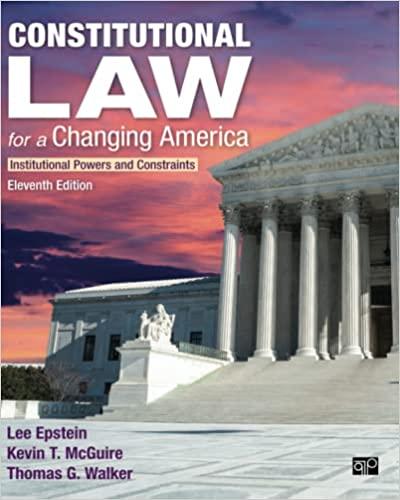Question
For each of the client fact situations presented below, use the following summary court opinion. For each fact situation answer the following: What are the
For each of the client fact situations presented below, use the following summary court opinion. For each fact situation answer the following:
- What are the fact similarities and differences between the court opinion and the client's fact situation?
- Is the court opinion on point? Why or why not?
- If the court opinion is on point, would it be mandatory or persuasive precedent?
Court Opinion:Vineyard v. Palo Alto. Mr. Vineyard was injured on December 29, 2009, in a car accident while delivering pizzas for his employer, Palo Alto. Mr. Vineyard began work for Palo Alto on October 1, 2009. He also worked as a horse trainer beginning on September 1, 2009. There is no dispute Mr. Vineyard is entitled to Worker's Compensation benefits reflecting his wages from both jobs. The parties disputed how to computethe aggregate weekly wage to be used to determine the value of those benefits.
For employment less than 26 weeks, 52-1-20(B)(1) of the New Mexico Workers Compensation Act compels dividing the total wages earned by the worker at that job by the number of weeks "actually worked in that employment." The Court of Appeals held that each employer's average weekly wage is to be individually calculated under subsection (B)(1) and an average weekly wage based on the aggregate of all averages should then be calculated.
Part A
Client's Facts:Samantha was an assembly line worker at a factory that produced plastic bags for use in retail stores. On January 9, 2016, the end of a conveyor line collapsed and crushed Samantha's foot. Samantha started working at the factory on October 1, 2015. Samantha also worked 20 hours a week for a nonprofit agency. She began working for the nonprofit agency on September 15, 2015. She is unable to work at either job for at least three months. The hearing officer assigned to calculate her benefits under New Mexico's Worker's Compensation statute 52-1-20(B)(1) has calculated her average weekly by averaging her hourly wage for both jobs and averaging the number of weeks she worked at the two jobs. Samantha wants to appeal the manner that the average weekly wage was calculated.
Part B
Client's Facts:Becky, a Wyoming resident, was injured while delivering packages for her employer, D2D (Distributor to Door). She began work for D2D on December 15, 2015. She also works as a dog trainer on weekends and began that job on September 1, 2015. Becky also worked providing closed captioning for a local agency. She had been at that job since August 1, 2015. Wyoming has a Workers Compensation statute that requires "dividing the total wages earned by the worker at that job by the number of weeks actually worked in that employment" for employment less than 30 weeks. There is no applicable Wyoming case. The parties disagree on how to calculate the average wage for purpose of determining benefits.
Step by Step Solution
There are 3 Steps involved in it
Step: 1

Get Instant Access to Expert-Tailored Solutions
See step-by-step solutions with expert insights and AI powered tools for academic success
Step: 2

Step: 3

Ace Your Homework with AI
Get the answers you need in no time with our AI-driven, step-by-step assistance
Get Started


